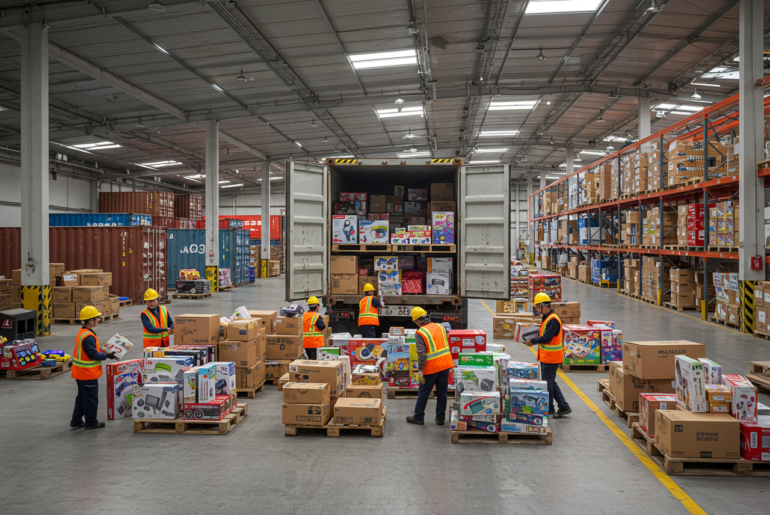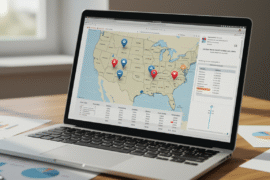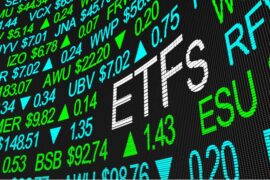This article may contain references to products or services from one or more of our advertisers or partners. We may receive compensation when you click on links to those products or services. Nonetheless, our opinions are our own.
The information presented in this article is accurate to the best of our knowledge at the time of publication. However, information is subject to change, and no guarantees are made about the continued accuracy or completeness of this content after its publication date.
Key Highlights
- The U.S. has imposed a 145% tariff on numerous Chinese imports, intensifying the ongoing trade war.
- While tech products received temporary exemptions, uncertainty remains.
- U.S. businesses that rely heavily on Chinese goods—particularly textiles and agriculture—are bracing for major impacts.
- Diversifying sourcing and adjusting supply chains are essential strategies to reduce risk.
- Understanding the evolving tariff environment is critical to revising business plans.
Introduction
The U.S.–China trade conflict has escalated with the implementation of a 145% tariff on a wide range of Chinese goods. This significant policy shift is disrupting global markets and forcing businesses to reevaluate their strategies to stay competitive in a volatile trade environment.
Understanding the 145% Tariff on Chinese Imports
The 145% tariff stems from ongoing trade tensions that began in 2018. Both countries have been exchanging retaliatory tariffs, and this latest U.S. measure makes Chinese imports significantly more expensive for American businesses and consumers.
While some tech products—like smartphones and semiconductors—received temporary exemptions, the future of these breaks remains uncertain. The broader trade climate remains unpredictable, heightening risks for import-reliant industries.
Overview of U.S.–China Trade Relations
The trade imbalance between the U.S. and China remains a core issue. In 2024, the U.S. imported $438.9 billion in goods from China while exporting only $143.5 billion, resulting in a $295.4 billion trade deficit—the largest with any single country.
China has responded with tariffs of its own—up to 125%—targeting American goods, particularly agricultural exports. These measures strain U.S. farmers and highlight how deeply the two economies are intertwined.
Voted "Best Overall Budgeting App" by Forbes and WSJ
Monarch Money helps you budget, track spending, set goals, and plan your financial future—all in one app.
Get 50% OFF your first year with code MONARCHVIP
Impact on Various Industries
| Industry | Impact |
|---|---|
| Textiles & Apparel | Higher input costs may lead to increased retail prices |
| Agriculture | Reduced exports may impact farm income, especially for soy and corn |
| Technology | Disruptions in electronics and semiconductor supply chains |
| Industrial Machinery | Increased costs for manufacturers relying on Chinese parts |
| Pharmaceuticals | Risk of shortages in ingredients and finished drugs |
These impacts could lead to consumer price hikes, dampened demand, and reduced business margins. Companies may face tough choices between raising prices and absorbing higher costs.
Beginner’s Guide to Changing Your Business Plan
To survive this volatile trade landscape, businesses must act swiftly and strategically.
Essential Resources and Preparation
Stay updated through reliable sources like Capital Economics and government trade data. Assess your exposure to Chinese imports, calculate the potential cost increases, and evaluate how Chinese retaliatory tariffs could affect your export markets.
Engage with legal and financial advisors, industry groups, and supply chain consultants to create an actionable mitigation plan.
Step-by-Step Guide to Strategy Adaptation
Step 1: Assess Your Supply Chain Vulnerabilities
Map out your supply chain to identify dependencies on Chinese goods. Evaluate how the tariff will affect your cost structure and consider indirect dependencies—suppliers that may source materials from China, even if they’re based elsewhere.
Step 2: Explore Alternative Markets and Suppliers
Seek suppliers in countries unaffected by the tariff. Nearshoring to Mexico or Canada offers benefits under the USMCA, such as reduced transit times and favorable trade terms.
Also consider Southeast Asia (Vietnam, Thailand, Malaysia) for manufacturing or emerging markets in Africa for labor-intensive industries, as global firms begin diversifying beyond traditional hubs like China.
Conclusion
The 145% tariff marks a turning point in global trade strategy. Businesses must respond proactively by identifying weak points, reducing reliance on single-source suppliers, and adopting a diversified approach to sourcing.
Flexibility and preparation are essential to turning today’s challenges into tomorrow’s opportunities.
Frequently Asked Questions
What products are most affected by the tariff?
Items such as appliances, electronics, apparel, toys, and machinery parts will see increased costs. Smartphones and gaming consoles received temporary exemptions.
How can small businesses lessen the impact?
Diversify suppliers, explore local production options, and consult available government support. Reducing reliance on any one market can enhance resilience.
Will consumers feel the effect of the 145% tariff directly?
Yes. As input costs rise, businesses are likely to pass these on to consumers, resulting in higher prices for many everyday goods.
Can local manufacturing fully replace Chinese suppliers?
Not immediately. While local production reduces dependence, it often comes with higher costs and capacity limitations, requiring significant investment and time.
How does the USMCA help with diversification?
USMCA offers trade advantages with Mexico and Canada, including simplified customs and duty-free movement of goods, making them attractive sourcing alternatives.

Reviewed and edited by Albert Fang.
See a typo or want to suggest an edit/revision to the content? Use the contact us form to provide feedback.
At FangWallet, we value editorial integrity and open collaboration in curating quality content for readers to enjoy. Much appreciated for the assist.
Did you like our article and find it insightful? We encourage sharing the article link with family and friends to benefit as well - better yet, sharing on social media. Thank you for the support! 🍉
Article Title: How the 145% Tariff on Chinese Imports Could Reshape Your Business Strategy
https://fangwallet.com/2025/04/16/tariff-on-chinese-imports/The FangWallet Promise
FangWallet is an editorially independent resource - founded on breaking down challenging financial concepts for anyone to understand since 2014. While we adhere to editorial integrity, note that this post may contain references to products from our partners.
The FangWallet promise is always to have your best interest in mind and be transparent and honest about the financial picture.
Become an Insider

Subscribe to get a free daily budget planner printable to help get your money on track!
Make passive money the right way. No spam.
Editorial Disclaimer: The editorial content on this page is not provided by any of the companies mentioned. The opinions expressed here are the author's alone.
The content of this website is for informational purposes only and does not represent investment advice, or an offer or solicitation to buy or sell any security, investment, or product. Investors are encouraged to do their own due diligence, and, if necessary, consult professional advising before making any investment decisions. Investing involves a high degree of risk, and financial losses may occur including the potential loss of principal.
Source Citation References:
+ Inspo
There are no additional citations or references to note for this article at this time.












































